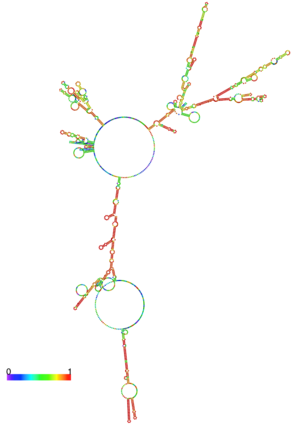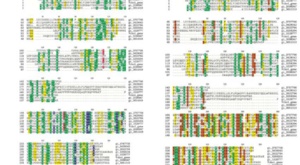VRC01 gp120 complex
From Proteopedia
The crystal structure of VRC01 and VRC01-like antibodies are studied to define with characteristics are important in neutralizing HIV-1. (cite!)
Contents |
Introduction
HIV-1 has a high level of antigenic and genetic diversity. HIV-1 has also evolved mechanisms to evade the humoral immune response. These aspects of HIV-1 have made it difficult to develop a vaccine. After several years of infection, 10 to 25% of HIV-1 infected individuals develop neutralizing antibodies. Some antibodies target the transmembrane gp41 molecules of the HIV-1 viral spike, however most target the surface protein gp120. (Wu) VRC01 and VRC01-like antibodies bind to gp120 and are able to neutralize about 90% of HIV-1 isolates. Structural analysis has shown which characteristics of antibodies are essential to its binding with gp120. (Kwong) Discovery of the structure of these antibodies can help develop an effective HIV-1 vaccine.
HIV-1 Neutralization
HIV-1 enters its host by binding viral gp120, a surface glycoprotein of HIV, to the host cell’s CD4 receptor. This interaction induces conformational changes in gp120. (Wu) This conformational change results in the exposure of a binding site for the co-receptor, usually CCR5 OR CXCR4. (Li) The conformational changes also result in the formation of a pre-hairpin intermediate conformation in which gp41, a transmembrane glycoprotein of HIV, rearranges its molecules so that its N-terminal peptides form a trimer of helices that present a fusion peptide to the target cell. Once fusion occurs between the fusion peptide and the target cell membrane, HIV is able to enter and infect the target cell. (Tran) VRC01 binds to CD4’s binding site on gp120, preventing the CD4 receptor from binding to HIV and infecting the cell. (Wu).
| |||||||||||
Further Study
Conclusive results about what activates ToxT itself has not yet been found. The varying activity of ToxT dependent on the presence of cis-palmitoleate or other unsaturated fatty acids represents a detailed method of effective pathogenicity in humans, but may not be a reasonable target for drug treatment. By restricting transcription (and thus translation and protein production) of virulence genes until the bacterium is determined to be in a favorable location for infection, Vibrio cholerae avoids wasting energy producing virulence factors that will just be cleared by the intestine. This is a specific mechanism to ensure that the bacterium also injects CT and TCP where they will do the most damage, perpetuating the infection. [5] Despite the lack of information about what activates ToxT itself, it is understood that the transcription of ctxA and tcpA by vibrio cholerae is sharply reduced in the presence of oleic, linoleic acid, and arachidonic acid, all of which are components of bile. Therefore, one may hypothesize that it may be possible to use the structure of a UFA or SFA to design a small molecule inhibitor of ToxT which may be used to treat or prevent cholera.
Evolution
Vibrio cholerae is a highly diverse species in which some strains are completely harmless, whereas other strains have the capacity to cause global cholera pandemics. It has been discovered that in each epidemic and pandemic strain, there is a chromosomal pathogenicity island (PAI) that is not present in the nonpathogenic strains. The region containing two ToxR-regulated genes (aldA and tagA) is composed of 13kb of previously unidentified DNA. [6]This region is part of a PAI that contains ToxT and a gene cluster a critical colonization factor and TCP. The PAI is 39.5 kb long, contains putative integrase and transposase genes, and inserts near a 10Sa RNA gene. One may infer that the PAI could have originated from a bacteriophage. This PAI was also found in two non-O1/non-O139 (which are both pandemic) sero type strains. Therefore, one may hypothesize that the PAI could be transferred within other strains of Vibrio cholerae.

HIV Prevention Research
In 2003, Veazey and fellow researchers found that early broadly neutralizing antibodies had microbicide potential by using a monkey cell as the model. The microbicide used on these monkeys consisted of b12, a broadly neutralizing antibody. These monkeys were challenged with SHIV, simian-human immunodeficiency virus, through the vagina. Only three of the twelve monkeys became infected. It was also found that the protection against HIV lasts for up to two hours. (Veazy)These results show that microbicides containing antibodies are effective at preventing HIV in monkeys.
A similar experiment was done in 2012; it used humanized mouse models called RAG-hu mice, which contained human target cells. Results show that seven out of nine mice that were administered the VRC01 antibody and all mice that were given a cocktail containing four broadly neutralizing antibodies as a topical gel were protected against HIV-1. These results showed that broadly neutralizing antibodies could be used as a topical microbicide to prevent vaginal transmission of HIV and that a combination of antibodies can provide better protection against HIV. When the VRC01 antibody and the broadly neutralizing antibody cocktail were administered to the humanized mice via the intravenous route, none of the mice were infected with SHIV. (Veselinovic)
References
Proteopedia Page Contributors and Editors (what is this?)
Amanda Valdiosera, Michal Harel, Chris Casey, Alexander Berchansky

